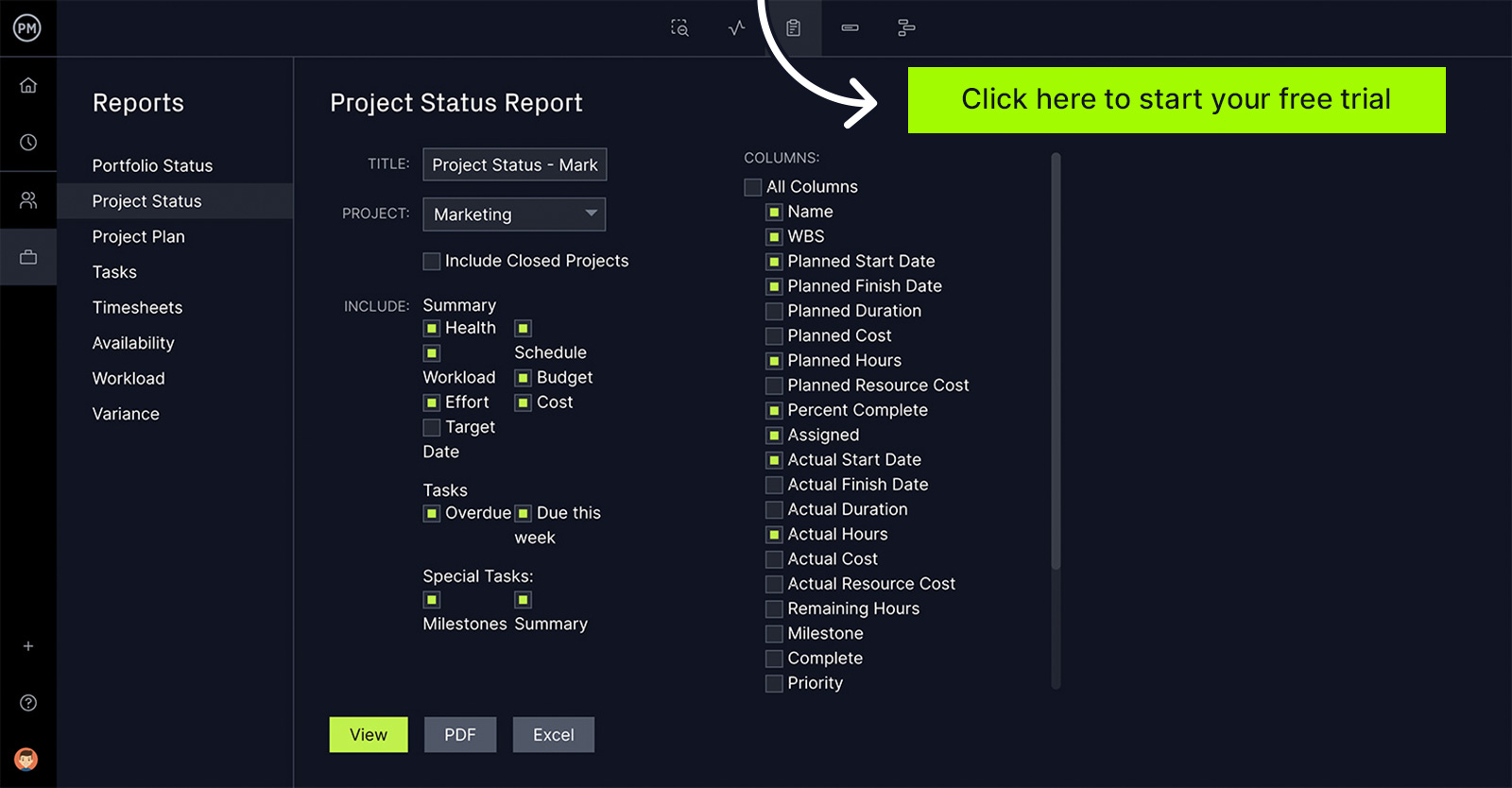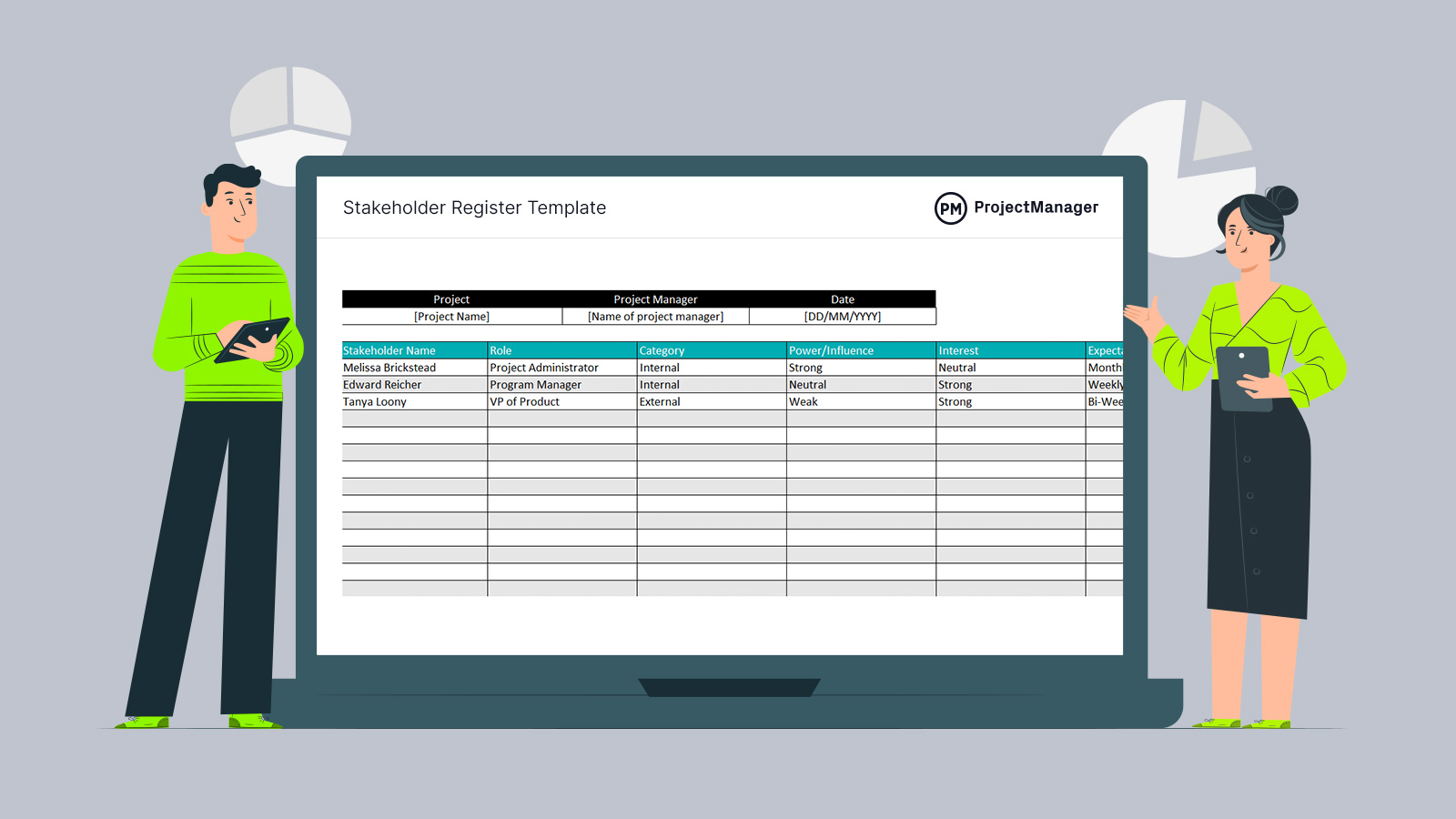Stakeholders are people with a vested interest in the project. They’re going to want to know how the project is progressing and whether it’s scheduled to deliver on time and within its budget. Project managers need to manage their stakeholders’ expectations.
What Are Stakeholder Expectations?
Stakeholder expectations are the criteria by which a stakeholder will consider the project a success. These are usually a combination of things, from the delivery of the final product or service meeting the quality expectations set up by the stakeholders to finishing the project on time and within budget.
Stakeholders will want regular updates and project managers can use these stakeholder presentations to manage their expectations. ProjectManager is award-winning project management software with customizable reporting features that can be easily shared in a variety of formats to keep stakeholders updated. It’s easy to generate status and portfolio reports, as well as reports on variance that can be filtered to show only the data that’s of interest to stakeholders. Get started with ProjectManager today for free.

Why Is It Important to Manage Stakeholder Expectations?
The last thing a project manager wants is to have stakeholders interrupting their day-to-day operations managing a project with questions about progress and spending. These are legitimate questions, but if a project manager doesn’t own that conversation it will pull them away from essential project work and could even jeopardize the project plan.
Of course, not all stakeholders are clients. Anyone with a vested interest in the project is a stakeholder. Team members are also stakeholders and managing their expectations is one of the most important aspects of stakeholder management process because it will build trust and develop greater relationships with the team, boosting morale and productivity, which leads to a smooth-running project.

Get your free
Stakeholder Register Template
Use this free Stakeholder Register Template to manage your projects better.
Get the Template
How to Manage Stakeholder Expectations in 6 Steps
It can be a challenge to manage stakeholder expectations, but it’s an important part of project management. Here are some steps you can take to get a handle on that process.
1. Identify Your Stakeholders
Before you can manage stakeholder expectations you have to know who they are. Identify all project stakeholders and their interests in the project so you can understand how they relate to the project.
2. Map Out Your Stakeholders
Once you’ve identified your stakeholders, use a map to visualize their relationship with the project. A stakeholder map has four quadrants, keep satisfied, manage closely, monitor and keep informed. You’ll place each stakeholder in the appropriate quadrant to better understand how to deal with them.
3. Gather the Expectations of Your Stakeholders
Understanding the expectations by interviewing them and getting their point of view, such as what criteria they would consider for a successful project. This information will help you manage their expectations over the life cycle of the project.
4. Create a Project Scope Document and Have It Approved by Stakeholders
A scope document explains the boundaries of the project. It will establish the responsibilities of the team and set up procedures for how completed work is verified and approved. Let your stakeholders review this document and approve it before implementing it so they understand how the project will move forward.
5. Create a Stakeholder Management Plan
A stakeholder management plan is used to define and document the approach and action to increase stakeholder support and reduce any negative impact they might have on the project. This involves identifying stakeholders and defining the level of power and influence they have on the project.
6. Communicate With Stakeholders Throughout the Project Execution
Once you have a plan you need to keep stakeholders informed. Find out how each stakeholder wants to get updated and the frequency of those updates. Then you’ll be able to give each stakeholder presentations as needed to keep them up to date, whether in person, by email, etc.
Video: Tips to Manage Stakeholder Expectations
Project managers must, at times, cater to the divergent expectations of multiple stakeholders. In this video with our very own Jennifer Bridges, PMP, learn how to manage stakeholder expectations and ensure they align with your project.
Here are some of the tips that any project manager should follow when managing stakeholder expectations.
- Document the stakeholders: Not everyone is a stakeholder. So many times when a project is initiated, there are different people within the organization, client members, team members, and vendor partners who try to give impact and feedback and request changes to the project plan. We need to remember they aren’t necessarily stakeholders. Typically, all organizations that are impacted by the project have stakeholders who are represented on the project and members of the change control board. But they have a representative that they go to that they answer to for the organization, so not everyone is a stakeholder.
- Enforce process: It’s important for a project manager to keep processes in alignment so other people in the organization, maybe a project manager or your team members and let them know that there’s a change management process. So if feedback needs to come through the project or decisions need to be made, it must go through the formal change management process.
- Provide frequent and regular status reports: Stakeholders typically have multiple projects going on so they’re attending many meetings and have many tasks. They’re looking at a lot of project reports trying to make decisions. The project manager needs to keep things documented, managed and delivered. That’s why it’s important to provide status reports frequently, regularly and in the format that’s appropriate for your stakeholders. Remember that executives require a different level of status than the team members. The team members may need more detail on their tasks while executives may need more details about the overall status and health of the project.
- Ask questions: Then touch base regularly and ask questions of your stakeholders. Contact them again and say, “How’s it going, what do you think about the project?” “Is it meeting your expectations?” By asking questions, you can see what concerns they have ahead of time. The last thing you want is to get in an executive meeting and you’re the last to know that you’re going to be hit with something that your team has missed.
- Dispel myths: Because the stakeholders have multiple projects and so many things going on, it’s hard for them to keep track of the different people within the project. When people outside the project give false information, that’s where myths come about. It’s important to constantly dispel those myths along the way and keep people informed about what’s actually happening in the project.
This is the ounce of prevention that’ll save you a pound of cure for keeping your stakeholder expectations aligned and on track. Follow this simple advice and you’ll have managed your stakeholder expectations. Better still, you’ll have pinned those expectations to a schedule that aligns with your project. Thanks for watching!
Free Stakeholder Management Templates
To help with stakeholder management ProjectManager has free stakeholder management templates. ProjectManager is the online hub for all things project management, including weekly blogs, tutorial videos and free project management templates for Excel and Word. Here are a couple that can help with stakeholder management.
Stakeholder Analysis Template
Use our free stakeholder analysis template for Excel to identify and manage your stakeholders. The free template captures names, titles and contact details as well as the level of their influence and much more.
Stakeholder Map Template
A stakeholder map visualizes how you will manage each stakeholder. By placing your stakeholders on our free stakeholder map template for Excel, you can chart the level of interest and influence of each.
If you’re looking for a tool that can help you keep your stakeholder expectations on track and in alignment, then sign up for our software now at ProjectManager.

